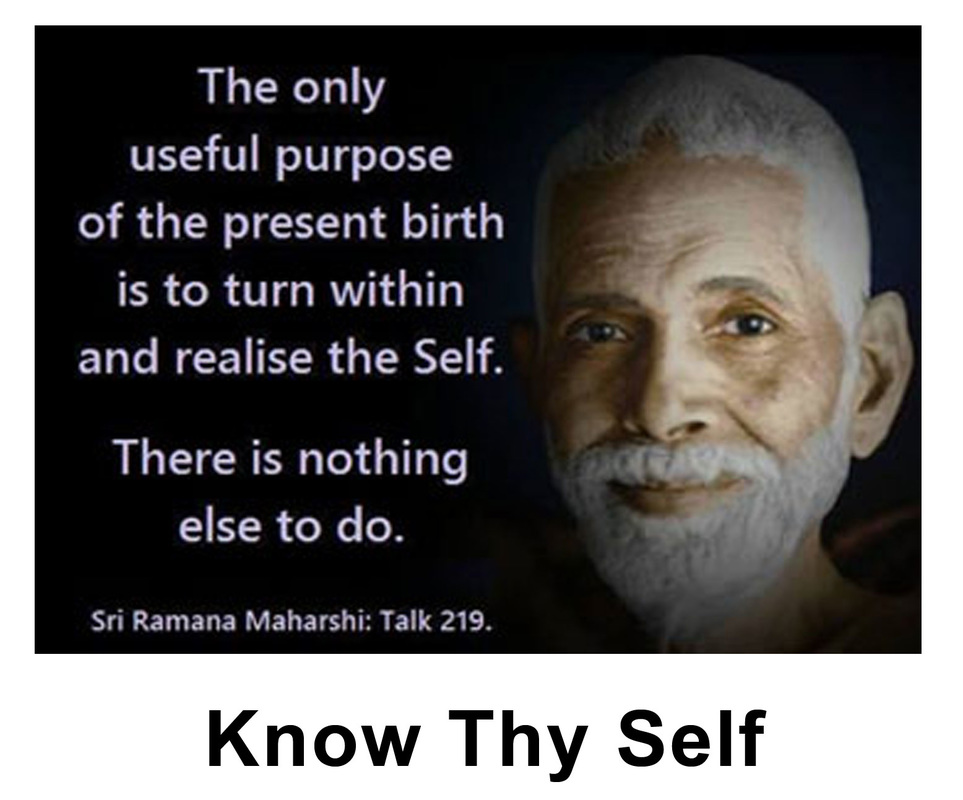 Delphic Temple of Apollo Delphic Temple of Apollo I've found that meditation, self enquiry, silence, speaking the truth and honest communication are strong medicines that awaken the spirit and enliven our wisdom-heart. “Tell me who you are” is the self reflective phrase heard over and over again echoing through an Enlightenment Intensive. Essentially it’s a modern rephrasing of the ancient Greek counsel ‘Know Thy Self’ that was inscribed on the entrance at the Delphic Temple of Apollo. The phrase 'Nosce Te Ipsum' (Know Thy Self) was meant to remind and inspire pilgrims who entered the temple in search of understanding and wisdom that the only real knowledge is for one to understand oneself. Later, Socrates, one of the founders of Western Philosophy taught that one must Know Thyself to be wise. He emphasised that the unexamined life is not worth living. In the 20th Century Ramana Maharshi, the non-duality ‘who am I’ guru said that if you ‘Know Thy Self,’ you know everything. The same wise counsel on the value of self inspection is repeated in age after after and tradition after tradition. ‘Know Thy Self’ is the aphorism at the core of the Buddhist practice of mindfulness. The Eastern philosophy of non-dual reality begins with contemplating on the nature of self. Western psychiatry’s Jungian psychoanalysis and the father of Humanistic Psychology, Carl Rogers direct one's attention to knowing the self. Roger's wrote that at the core of the problems that patients were raising in therapy with him was the question, who am I. ‘Who am I’ and ‘Know Thy Self’ are brother and sister. Both are born from the same courageous and heroic tradition of self enquiring into the nature of oneself, life and others. Both requires you to ‘go to the edges’ where what you know meets the world of what you don’t know. Or more accurately what you know meets the world of what you didn’t know you knew.  As my good friend Joseph Rubano wrote in his enlightenment inspired poem, Go to The Edges, (www.amazon.com/dp/B01E680RSQ) “There is a Self you can find by going inside. But don't go only there. Go to the edges, stretch it thin like the skin of a drum. Give up making only dull thuds Give yourself up to singing. Go to the edges..." SELF ENQUIRY EXERCISE In this exercise do any activity of your choice with self reflection or mindfulness. The term ‘mindfulness’ comes to us from the Buddhist traditions and is a term increasingly used today to describe a self reflective process where you are actively observing yourself and your thoughts and feelings without judging them as good or bad. You are the observer or witness. It’s often described as living in the moment. A good place to start this exercise is right here and right now. Notice yourself. Notice yourself reading these words and the meaning they have for you. Notice how your body is feeling. Do you feel relaxed? Do you feel the skin on your clothes? Mindfulness or Knowing Thy Self is as simple as observing and witnessing what your are conscious of at any given moment. At various times of the day and for however long you choose bring your attention to this Knowing Thy Self moment. You can think of it as a ‘pause’ in your working activity, something like a healthy alternative to the coffee or cigarette break. In Australia we’d call it having a ‘cuppa’ or ‘smoko’ break. And this sort of break can be done right at your desk or what ever work activity you are engaged in. It’s a shift in conscious awareness of the present moment. As we say here in Australia, “give it a go.” EXERCISE 1. Write me your thoughts, feelings and experiences about this little Know Thy Self exercise. 2. Continue with a 10 – 15 minute quiet time mediation once or twice each day. 3. Keep a spiritual journal of what you become conscious of. I welcome your thoughts and experiences. You can send them to me via a return email, a FB private message or post to the public Face Book group page. https://www.facebook.com/groups/EnlightenAustralia/ Blessings and Love Yoah Yoah Wexler, PhD [email protected] http://www.enlightenmentintensive.com.au http://www.amazon.com/author/yoah
0 Comments
 image by Jean M Mas (2/2007) image by Jean M Mas (2/2007) Charles Berner wrote: “It seemed to me that the age-old technique of reflecting on "Who am I?" was a very good one. But it was slow. I wondered what could be done to speed it up. I had years of experience in working on communication techniques, learning how people could communicate better with each other, especially on a one-to-one basis. For years I had worked with the dyad format and investigated its various aspects and I had made some fundamental observations. I observed that the mind is generated when something is not communicated between individuals. That is a core principle. The mind is generated when something is not communicated between individuals. For example, if I say something in this talk and you don't understand it, then we will have contributed to the mind and put more into it because communication will not have successfully taken place. If, on the other hand, you understood it, then we have successfully communicated and it is not stored in the mind. When something is completely received, it leaves the realm of the mind and enters the realm of knowingness. This is another important principle. The Enlightenment Technique is partially built around these observations and fundamental principles.” Source: Enlightenment and the Enlightenment Intensive; Volume 1. http://www.amazon.com/dp/1492267546 |
Archives
December 2023
|






 RSS Feed
RSS Feed